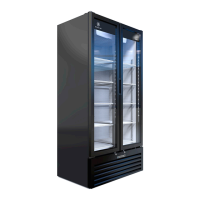User Manual for MT Refrigerators and Freezers Beverage-Air
Rev. 10/22Beverage-Air16
Refrigeration service should only be attempted by a trained trade professional certied to work on R-290 or R-600
systems.
Here are some critical service items.
This list does not qualify anyone to service the unit. It is a
reminder and checklist for the service tech. Keep these in
mind for R-290 and R-600 service:
• Wire nuts are NOT to be used when changing an
electrical part.
• The switches in this product are sealed, only exact
replacements may be used.
• The process tubes are to be used for service access.
• Cut out (with tubing cutter) refrigeration components
that are to be replaced. Do NOT un-braze.
• Because this refrigerant can be vented into the
air during service, the venting MUST be in an area
free from ame or spark. It must be near an opened
window or door.
• A sign noting service of a system containing propane
must be attached to the unit during refrigeration
service.
• A combustible gas leak detector must be used to
inform anyone in the area when propane is present in
the air.
Other Information:
Recovery: If opening the system, all remaining refrigerant
must be recovered.
Evacuation: It is critical that a refrigeration system be
leak free and internally dry. A thorough evacuation with
a good vacuum pump with a micron gauge attached is the
only way to ensure that the system is dry and ready for a
charge of refrigerant.
Charging: The system is critically charged and the proper
type and amount MUST be weighed in.
Overcharge symptoms: Unit will cool properly but
the suction line temperature will be unusually cold.
Compressor run time will be longer than normal.
Undercharge symptoms: Long run time, poor cooling and
a hot compressor dome are the main symptoms of an
undercharge.
Selected System Components and Denitions:
System - Hermetically sealed system that includes
compressor, nned condenser, nned evaporator, and
capillary tube metering device.
Compressor - Vapor pump that moves the refrigerant.
Condenser - Finned tubes that contain hot refrigerant gas,
condenser fan moves air over it to discharge heat. Air
contains dust and other contaminants, causing eventual
need for cleaning.
Fan Motor - Related and used with the condenser, the fan
motor rotates the fan, moving air across the condenser.
Air ow is out the back of unit. The fan motor will be
operating in conjunction with the compressor, unless the
compressor has overheated, in which case the fan motor
will be on when the compressor is not operating.
Evaporator - Finned tubes that contain low pressure
refrigerant, evaporator fan (when used) moves cabinet air
over it to extract heat.
FOR THE SERVICE TECH R-290 AND R-600

